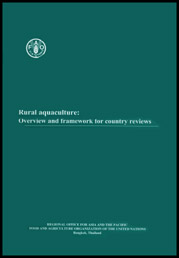
Peter Edwards and Harvey Demaine
Agricultural and Aquatic Systems Program
School of Environment, Resources and
Development
Asian Institute of Technology
Bangkok, Thailand
REGIONAL OFFICE FOR ASIA AND THE PACIFIC
FOOD AND AGRICULTURE ORGANIZATION OF THE UNITED
NATIONS
Bangkok, Thailand, 1998
|
The designations employed and the presentation of material in this publication do not imply the expression of any opinion whatsoever on the part of the Food and Agriculture Organization of the United Nations concerning the legal status
of any country, territory, city or area or of its authorities, or concerning the
delimitation of its frontiers or boundaries. |
The copyright in this publication is vested in the Food and Agriculture Organization of the United Nations, This publication may not be reproduced, in whole or in part, by any method or process, without written permission from the copyright holder. Applications for such permission with a statement of the purpose and extent of the reproduction desired should be made through and addressed to the Regional Aquaculture Officer, FAO Regional Office for Asia and the Pacific, Maliwan Mansion, Phra Athit Road, Bangkok 10200, Thailand.
2. History, status and potential of rural aquaculture
3.1 Sustainable development
3.2 Developmental issues3.2.1 Major problem areas
3.2.2 Rural versus peri-urban aquaculture
3.2.3 Revolutions3.3.1 Nutritional aspects of fish
3.3.2 Fish in food security
3.3.3 Aquaculture or capture fisheries?
3.3.4 Fish for food or income?
3.3.5 Poverty alleviation and rural aquaculture
4. Systems framework for rural aquaculture
4.1 General framework
4.2 Production technology4.2.1 Cultured species
4.2.2 Culture facilities
4.2.3 Husbandry
4.2.4 Integrated agriculture-aquaculture4.3 Social and economic factors
4.4.1 Impact of the natural environment on aquaculture
4.4.2 Impact of man-made environmental changes on aquaculture
4.4.3 Impact of aquaculture on the environment
5. Guidelines for promoting rural aquaculture
5.1.1 Purpose, concepts and means
5.1.2 Human resource capacity
5.1.3 Multidisciplinarity and balance5.2 A systems approach to aquaculture research and extension
5.3 Planning and management for rural aquaculture
5.3.1 Decentralised planning for aquaculture development
5.3.2 Information needs and data collection
5.3.3 Project planning and implementation
5.3.4 Monitoring and evaluation5.4.1 Donor projects and national agencies
5.4.2 Non-governmental organisations
5.4.3 Institutional home for rural aquaculture
6.1 Definition and issues
6.2 Sustainable rural aquaculture farming systems
6.3 Promoting rural aquaculture